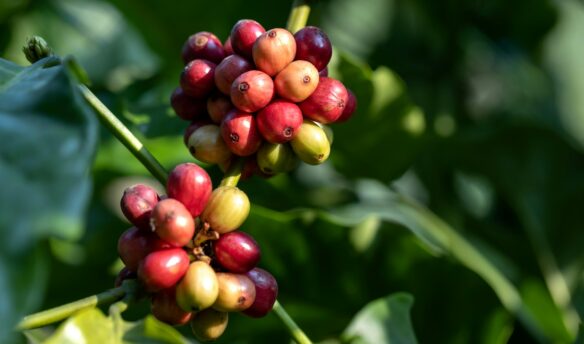It turns out that making iced coffee at home is trickier than you think. Plus, coffee prices skyrocket, and Canadian researchers discover a new way to convince people to ditch disposable cups: gambling.
‘Coffee Gets Even Pricier as Futures Rally to Highest Since 1977’ – via Bloomberg
Coffee prices for arabica and robusta have soared over the past year, with arabica reaching highs not seen since the late-1970s.
The arabica futures market—known as the C price—reached $3.30 per pound as of this writing (although the market is so volatile that it could have increased or decreased wildly by the time you read this).
The reasons for the jump in price are complex. Weather conditions in Brazil, Vietnam, and Colombia have stoked fears about coffee production drops, and uncertainty over the EU’s deforestation legislation and the incoming Trump administration’s tariff threats have exacerbated concerns.
Many news reports have reported on the price increase, with most focused on the possibility that consumers will have to pay more for coffee. That speculation isn’t totally off: Nestlé recently said it will raise prices and shrink the size of its coffee bags due to increased green coffee costs.
However, price fluctuations also impact producers and exporters. Two of Brazil’s largest exporters recently filed for debt renegotiation due to cashflow issues from rising costs.
There is also the issue that the C price doesn’t always reflect how coffee is bought and sold. Bram De Hoog, managing director of the farmer-owned roasting company Paso Paso, wrote a piece summarizing his perspective on the current spike. “If a farmer has coffee available to sell right now they will be paid for it according to the market,” De Hoog wrote. “However, many farmers sell their coffee before it is actually harvested as they need the contracts to secure harvest finance,” which means they might not benefit in the long term from recent spikes.
Farmers need to see consistently higher prices for their coffee; if they do, producers can earn more and reinvest in their farms. It remains to be seen whether this spike will endure or drop again, as has happened with previous surges.
Read the full story here or via Yahoo! Finance here.
‘Nestle and Keurig Want You to Make Iced Coffee at Home Instead of Paying a Barista. That’s Harder Than it Looks’ – via CNN
Iced coffee is very popular across the globe. Cold drinks make up 75% of Starbucks’ coffee sales, leading many U.S. brands to lean into customized iced beverages to compete. Meanwhile, cold coffee aficionados in South Korea coined a phrase to celebrate the country’s love for the iced Americano.
With all this hype, it’s no wonder that the big single-serve capsule manufacturers would want to get in on the action. But is cafe-quality iced coffee at home even possible?
As reported by Ramishah Maruf for CNN, Keurig Dr Pepper recently launched an iced coffee-specific brewer called the K- Brew + Chill™. At the same time, Nescafé debuted an espresso concentrate for making iced drinks at home, advertising the product as “needing no special equipment or barista skills.”
There has also been a rise in the popularity of at-home single-serve espresso machines, especially among younger coffee drinkers. “Partly this is due to financial pressures with many consumers choosing to spend more on premium items for their home than buying out of home drinks,” trend forecaster Jennifer Creevy told CNN, “but it also speaks to the experimental and individual nature of the younger generations.”
However, at-home iced coffee can be underwhelming. There’s a reason for this, according to coffee scholar Christopher Hendon. Most cold brew is steeped overnight because cold water takes more time to extract flavor from coffee grounds.
“The fundamental problem with how these capsule machines brew coffee is that there’s actually less coffee in those pods than are used to brew cold brew and other drinks in cafes,” Hendon told CNN.
So, despite the marketing, at-home iced coffee technology might not be there just yet—perhaps it’s best to stick to that mason jar of cold brew for now.
‘Want Folks to Use Reusable Mugs? Give Them a Chance to Win Free Coffee: UBC Researchers’ – via Toronto Sun
How do you encourage consumers to nix disposable coffee cups and bring their own reusable mugs? Many cafes offer discounts for reusable cup use; others charge extra for disposables; some cities have cup-swap and surcharge schemes; while a few companies and some Australian states have banned disposable cups altogether.
But what about taking a totally different approach: some light gambling?
A new study from the University of British Columbia’s psychology department, published in Resources, Conservation and Recycling and reported on by Tiffany Crawford for the Vancouver Sun, offered students at campus cafes the chance to win a free coffee if they opted for reusable cups—and it worked.
The psychologists relied on the power of anticipation—that exciting moment where you think you might win something, even if it’s just a cup of coffee—to encourage students to bring their reusable cups. Participants were given a 10% chance of winning a free coffee or a 5% chance of winning a $5 gift card if they brought their own cup. “Reusable cup usage more than doubled at the study site when the chance to win a free coffee was offered,” Crawford wrote.
Lead author Dr. Jiaying Zhao noted that even a tiny chance of winning was more attractive than a stamp card or other reward. “You say, ‘Oh I have a decent chance of getting a free coffee.’ And that’s the exciting part,” said Zhao.
More News
‘Ethiopia’s New National Coffee Platform to Boost Exports‘ – via Further Africa
‘Starbucks Holiday Red Cup Day Gives Coffee Chain Much Needed Jolt‘ – via Bloomberg
‘Brazilian Coffee Exported via Sailing Ship in Sustainability First‘ – via Global Coffee Report
‘Customers at This Starbucks can Sip Coffee and Observe a Quiet North Korean Village‘ – via the Associated Press
‘Do Light Roasts or Dark Roasts Have More Caffeine? Study: Maybe Medium?‘ – via Daily Coffee News
‘Starbucks Helps Distribute Millions of Coffee Seedlings in Colombia’ – via Global Coffee Report
The Week in Coffee Unionizing
In October, Starbucks Workers United reached a milestone, filing 500 successful union elections across the country. The union continues to negotiate with Starbucks over a framework for collective bargaining agreements, but in the meantime, the number of unionized stores is still ticking upwards.
According to a post by the union on Bluesky, workers at stores in Oceanside and San Jose, California; Baton Rouge, Louisiana; Salt Lake City, Utah; Springfield, Missouri; Buffalo, New York; and two in New York City all voted to unionize over the past week or so. Workers at a store in Benton, Arkansas, also won their election, according to local news reports.
The total now stands at 525 unionized locations, covering 12,000 employees in at least 43 states. “Considering that this is an industry that a lot of us are going to work in for a lot of our lives, we kind of have to be the change that we want to see,” Sunny Boudreau-Rutherford, a barista at a newly unionized Starbucks in Springfield told Ryan Collins of the Springfield Daily Citizen. “It begins and starts with us. And unionizing is a really strong way to get your voice heard.”
Coffee and the Climate Crisis
Adapting coffee production to a changing climate is thought to be difficult at lower altitudes while more manageable on hillsides where the weather is cooler.
Some producers have even moved their farms uphill, although that can often lead to other problems like increased deforestation. Others have switched from growing arabica to the hardier robusta, or, in extreme cases, given up coffee farming altogether.
To see whether arabica coffee could still thrive at lower altitudes, a team of researchers in Costa Rica spent eight years exploring the possibility of growing coffee under shade in the country’s low-altitude Caribbean region. The study, published in the journal Agriculture, found that “coffee cultivation in unconventional areas can uphold Costa Rica’s renowned coffee standards, presenting a promising adaptation strategy amid climate change,” according to a report in Tico Times.
The researchers used specific plant hybrids and fertilization techniques and grew plants under shade at a test farm only 43 meters above sea level. They found that their test plants could produce more coffee per hectare than those in more traditional—and higher altitude—growing regions.
“This project demonstrates that lowland coffee farming can sustain Costa Rica’s signature coffee quality, especially when genetically enhanced coffee hybrids are cultivated alongside forest species with optimized fertilization,” lead author Victor Hugo Morales said.
The study also showed that these techniques could allow production to restart in regions where coffee was once cultivated. “After more than eight years observing the benefits of coffee hybrids, we are eager to share these insights with producers to enhance profitability and ensure the long-term sustainability of Costa Rica’s coffee industry,” Morales said. “These efforts could have a profound impact on local communities.”
Beyond the Headlines
‘Read Now: Fresh Cup’s Top 2024 Interviews’ by Ashley Rodriguez
















